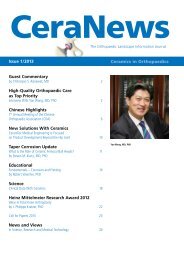BIOLOX - Nanocomposite for Arthoplasty
The Fourth Generation of Ceramics
The Fourth Generation of Ceramics
You also want an ePaper? Increase the reach of your titles
YUMPU automatically turns print PDFs into web optimized ePapers that Google loves.
Tribology and Arthroplasty<br />
Competence in Ceramics<br />
Material Properties<br />
The Strengths of <strong>BIOLOX</strong> ® delta<br />
Large Diameters<br />
12<br />
Enhanced Biomechanical Properties<br />
The advantages of ceramic materials are<br />
especially apparent in large diameters<br />
(≥32mm). Simulator studies show that<br />
the rates of wear remain low despite the<br />
significantly larger friction surfaces, i.e.<br />
significantly lower than those of other<br />
materials. With ceramic components,<br />
surgeons are no longer <strong>for</strong>ced to make a<br />
tradeoff between wear rates and diameter,<br />
and can instead choose the best option <strong>for</strong><br />
their patients.<br />
Better Tribology<br />
Dramatically reduced wear, expanded<br />
range of motion and increased resistance<br />
to dislocation make this bearing the number<br />
one choice when it comes to functional<br />
improvement, durability and safety. In<br />
contrast to bearings with conventional<br />
and highly crosslinked polyethylene, the<br />
rate of wear does not increase <strong>for</strong> ceramicon-ceramic<br />
bearings in the case of larger<br />
diameters. Given that <strong>BIOLOX</strong> ® delta shows<br />
even lower rates of wear in the simulator<br />
than <strong>BIOLOX</strong> ® <strong>for</strong>te, one can expect that<br />
it is superior to all other materials <strong>for</strong> bearings<br />
with large diameters.<br />
Hip Joint Simulator – Highly Crosslinked Polyethylene<br />
Long-term wear rate after 10 million cycles<br />
Negative Effect of Increased<br />
Metal Head Size<br />
Volume wear rate (mm 3 per million cycles)<br />
Hip Joint Simulator – Highly Crosslinked Polyethylene<br />
Long-term wear rate after 10 million cycles<br />
Positive Effect of Alumina Ceramic<br />
Femoral Ball Head Compared to<br />
Metal Femoral Ball Head<br />
Volume wear rate (mm 3 per million cycles)<br />
12<br />
12<br />
10<br />
8<br />
6<br />
4<br />
2<br />
0<br />
28mm<br />
Metal femoral<br />
ball head on XPE<br />
36mm<br />
Metal femoral<br />
ball head on XPE<br />
Fisher J, University of Leeds, 2006<br />
10<br />
8<br />
6<br />
4<br />
2<br />
0<br />
36mm<br />
Metal femoral<br />
ball head on XPE<br />
36mm<br />
Alumina ceramic<br />
femoral ball head on XPE<br />
Source: Fisher J, University of Leeds (UK), 2006<br />
Fisher J, University of Leeds, 2006












